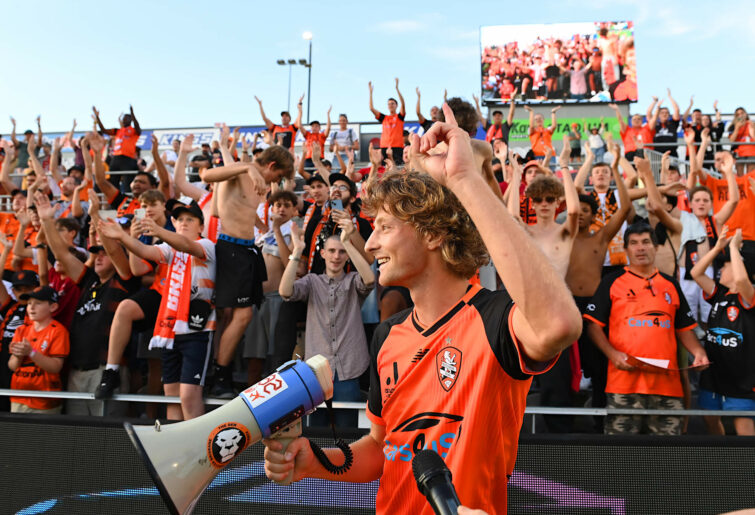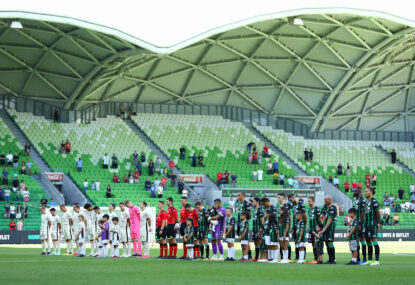Too often, it feels as though there is a lot of talk around achieving the unachievable when it comes to growing football in Australia without actual action implemented by the FA and now new governing body, the Australian Professional Leagues (APL)
In February last year, APL chief executive Danny Townsend remained confident that the trajectory of the code would trend upwards.
“We’re in a situation now where there shouldn’t be any concern around the game moving forward. We’ve gone through the well-publicised capital raising with [investment firm] Silver Lake, we’re well-capitalised and we’re here for the long haul.
The A-League Men competition is about being the number one men’s competition in Australia – of any code – by 2030,” Townsend said.
Every football fan in this country wants to believe that the sport can one day reap the full rewards of its untapped potential. In reality, any realist will tell you that these comments only fuel desperation, which in turn creates false hope.
Let’s begin with the smallest contributor to the code’s immobility, the fans.

(Photo by Albert Perez/Getty Images)
Memories will haunt many regarding those ‘fans’ of Melbourne Victory who disgracefully stormed the pitch during the Melbourne derby in December. That tarnished the reputation of the league, but it was a small proportion of idiots.
The first 12 seasons of the A-League produced an average crowd of 12,382, with the highest coming in the 2007/08 season totalling 15,348.
Sure, the hype around the new competition was immense and it was a period where the code was buzzing, but the league has experienced a drop off in attendance since the 2017/18 campaign, averaging a disappointing 8,194 fans, albeit with Covid playing a part in the disruption.
Even this season, with an average crowd of 7,474, the crowd discrepancy between best and worst is far too big. Using Sydney as an example, 34,232 and 9,714 is the difference between their best and worst turnout for home matches.
It can’t just be that large crowds are experienced in derbies but not the remainder to grow the game.
Imagine if we could achieve the same consistent enthusiasm, interest, and passion as what was displayed during the World Cup at Federation Square and all around Australia into the A-League.
Yes, the World Cup is held once every four years and it’s the biggest sporting event on the planet, but the fans have their part to play and at the end of the day it’s their decision. It’s not just them though – the product needs to also be attractive and worth the money which is why I stated that it’s the smallest part of the issue.
To make this code the biggest in the country by 2030 is an incredibly tough ask. Have the APL done enough so far to suggest they’re on their way to hitting that target? I wouldn’t say so.
On Saturday night, the fixtures for the AFL and NRL were not the biggest marquee matches, and the A-League had an opportunity to once again exploit this.
Instead, their scheduling continues to baffle many.
The clear change that needs to occur is scrapping the 3:00 time slots and pushing it back to a later time, especially during the summer heat.
A drinks break in between each half doesn’t cut it for the players and more importantly, the spectators, because enhancing the product through producing better entertainment and quality on the pitch is only going to keep the interest growing.
Adelaide’s brilliant performances this season were deservedly rewarded by performing in front of a sell-out of over 14,000 at Coopers Stadium, but why was this fixture not scheduled for Saturday night? Surely, you’d think a 7:45 kick-off during primetime Saturday would make more sense than a 5:00 kick-off on Good Friday?
With all due respect to Macarthur, they haven’t marketed themselves to the point of attracting big crowds, and despite the exciting 2-2 draw against the Wanderers accompanied by late drama, Adelaide-Sydney was another missed opportunity for the league to capitalise on.
Of course, there was the debacle that unfolded late last year surrounding the hosting rights of the Grand Final, as the APL thought it was a great idea to not consult the majority of the stakeholders associated with the code and take the $10 million reported deal to see Sydney host the next three Grand Finals.
Some will fairly argue that unpopular decisions are sometimes within the best interests of the game, but what is the end goal exactly? Yes, the A-League will become financially better off having executed the deal and I don’t think anyone is disputing that.
However, using one of the biggest clubs in the world in the form of Manchester United as an example, their owners have successfully made consistent revenues and marketed the club on a global scale like never before, if only the results on the pitch could also justify that.
So, if one of the APL’s long-term visions involves improving the wealth of the competition through hosting rights and investment firms that Townsend mentioned, how will that money be utilised to tackle issues such as grassroots and youth system development and affordability of junior fees?
It wouldn’t hurt to also try and push a tad more emphasis and attention on the advertising and promotion side of the game.
I’m truly astounded by the number of people I know who are unaware of what is happening in the A-League regarding fixtures, news, and updates.

(Photo by Daniel Pockett/Getty Images)
The partnership with Channel 10 and Paramount (you would think) opened up so much potential to advertise a code desperate for some kind of exposure and limelight. What’s more disappointing though, is the decision to cut broadcast matches from airing on free-to-air altogether this season and switch to only 10Bold and Paramount (a subscription that has experienced its fair share of frustrating technical errors.)
To even consider becoming the number one code in Australia by 2030, this basic fundamental step is pivotal and is non-negotiable.
This leads to my last point, the fault of the media.
While I was casually flicking through the channels, I came across Fox Sports News where they had prioritised the EPL highlights over the A-League which I found incredibly disappointing.
Australia is associated with the Commonwealth, but does our alliance tie so strongly that we care about English football over our very own? Honestly, it’s complete rubbish.
2030 is a difficult target because it’s going to take a substantially long time to earn the respect of many media outlets. What have the likes of Channel 10 and the APL done to make the A-League more visible? It continues to be a frustrating but ultimately sad reality.
Channel 7 hosting the Women’s World Cup in a few months is also a disaster waiting to happen. Increased non-football advertisements, poor coverage, along with an unwillingness to promote the tournament more than it should wouldn’t be crazy predictions.
Of course, other problems run deeper to the core of the issue which are separate discussions to be had.
For now, most of those points highlighted are frustrations stemming from what occurred last week.
All of those hurdles seem simple to overcome, right? Apparently not.































































































